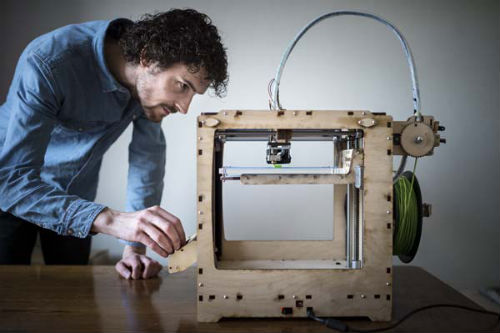
Printing in 3D is hip and extremely high tech. And it is environmental friendly. VHL student Tobias Strating is eager to demonstrate this with his printer and educational materials. The machine is humming softly, the room is filled with a smell that reminds of a glue pistol. From a small opening a warm, green substance appears that hardens within no time. First there was nothing, exactly thirteen minutes later there is a real Lego stone.
3D printing is still unknown to many people. But if you ask Tobias Strating (28), this is about to change soon. The third year student Environment at VHL University of Applied Sciences organises projects to introduce this new technology to children. “I like showing them that technique is actually quite cool.” This is not the only aim of the projects, which he organises in cooperation with the province of Fryslân and House of Design. Sustainability and an environmental friendly way of operating is just as important.
Students of De Trilker – a school for specialised education in Leeuwarden – were very enthusiastic when they got to design their own little boat. Their drawings were put in the computer by students of TU (Technical University) Delft and printed in 3D. “Kids who didn’t have a large concentration span were captivated for hours and they even asked their teachers if they could skip the break this time,” Tobias laughs. He consciously chose to work at a school for children with educational disadvantages and developmental disorders. “These kids are usually not at the forefront. This project gives them an advantage for a change.”
The boats were equipped with solar cells, which made them totally environmental friendly. Also children on the island of Vlieland were pleased with one of Tobias’ projects. They got to make a drawing with their finger on an iPad, which then was printed in 3D. At the same time, children were educated about waste, ‘dirty’ plastic based on petroleum oils opposed to environmental friendly plastic. At the end, they received a document, stating that they now knew all about 3D printing and bioplastics. “Many children still have this document hanging in their room.”
Due to the many innovations in technology, Tobias is foreseeing a third industrial revolution. “Wonderful, as far as I’m concerned, but preferably as sustainable as possible.” He himself only uses sustainable materials such as plastic made from starch or corn instead of petroleum oils. A 3D printer uses a so called additive technology, meaning that material is constantly added, in stead of chopping or cutting away material to create a shape. This is better for the environment. And less transportation is needed when people are able to print their own products.
“In this way, the recipe is transferred around the world, instead of the cake.” You can find designs all over the internet. Anything is possible, it is a very open source culture. For €1.200 you can buy a construction package, and assemble your own printer. The student occasionally prints items for himself as well. It can be pretty useful to create spare parts: “My mother in law owns an old Citroën, that is missing some parts here and there. I would be quite happy to print some parts for her.” He also has enough plans for school projects. For example, he applied for funding at the EU to organise 3D printing projects all over Europe, and he is assisting in the making of a teaching curriculum for secondary schools throughout the Netherlands.
“Yes, it certainly keeps me busy,” Tobias confirms. “But as long as I can combine this work with my education, I will continue doing it.”
(Source: Leeuwarder Courant)
Photo: SymbioShape
